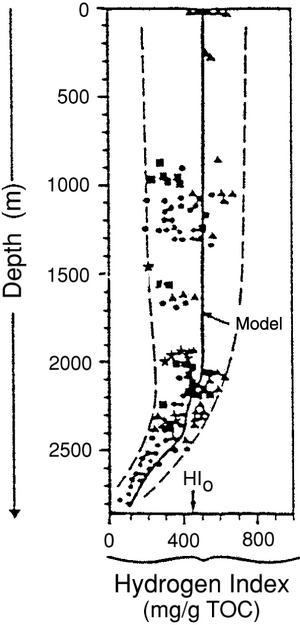Hydrogen Index (HI)
| Exploring for Oil and Gas Traps | |

| |
| Series | Treatise in Petroleum Geology |
|---|---|
| Part | Critical elements of the petroleum system |
| Chapter | Evaluating source rocks |
| Author | Carol A. Law |
| Link | Web page |
| Store | AAPG Store |

Gross trends of hydrogen indices (HIs) can be used as a maturation indicator. The hydrogen index is calculated from Rock-Eval data using the following formula:
where S2 is the amount of hydrocarbons generated through thermal cracking of nonvolatile organic matter in mg/g of rockCite error: Invalid <ref> tag; invalid names, e.g. too many and TOC is total organic carbon in %.
How to apply HI
Hydrocarbon generation zones can be indicated in the HI data for a uniform source section when HI decreases with depth. Inconsistencies due to changes in organic facies or the chemistry of the source rock can produce shifts in the HI data which are not indicative of maturation trends. Therefore, be sure the source is of uniform character when applying this concept.
Figure 1 shows a decreasing HI trend for a source rock beginning to generate hydrocarbons at a depth of approximately depth::2200 m.
See also
- Evaluating source rock maturity
- Maturation
- Tmax
- Vitrinite reflectance
- Apatite fission track analysis
- Spore coloration and thermal alteration indices
- Production Index (PI)
- Rock Eval analysis using hydrogen index (HI) and oxygen index (OI)
References
- ↑ Ungerer, P., P. Forbes, and J. L. Rudkiewicz, 1991, Computer modeling of the interplay between generation and expulsion of petroleum: a new advance in synthesizing geochemical data: Proceedings of the 13th World Petroleum Congress, Buenos Aires, p. 179–189. Discusses the relationships between a number of maturation indicators and petroleum generation and migration.
